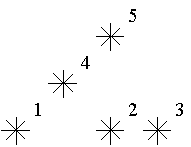Stars
| Time Limit: 1000MS | Memory Limit: 65536K | |
| Total Submissions: 49716 | Accepted: 21439 |
Description
Astronomers often examine star maps where stars are represented by points on a plane and each star has Cartesian coordinates. Let the level of a star be an amount of the stars that are not higher and not to the right of the given star. Astronomers want to know
the distribution of the levels of the stars.

For example, look at the map shown on the figure above. Level of the star number 5 is equal to 3 (it's formed by three stars with a numbers 1, 2 and 4). And the levels of the stars numbered by 2 and 4 are 1. At this map there are only one star of the level 0, two stars of the level 1, one star of the level 2, and one star of the level 3.
You are to write a program that will count the amounts of the stars of each level on a given map.

For example, look at the map shown on the figure above. Level of the star number 5 is equal to 3 (it's formed by three stars with a numbers 1, 2 and 4). And the levels of the stars numbered by 2 and 4 are 1. At this map there are only one star of the level 0, two stars of the level 1, one star of the level 2, and one star of the level 3.
You are to write a program that will count the amounts of the stars of each level on a given map.
Input
The first line of the input file contains a number of stars N (1<=N<=15000). The following N lines describe coordinates of stars (two integers X and Y per line separated by a space, 0<=X,Y<=32000). There can be only one star at one point of the plane. Stars
are listed in ascending order of Y coordinate. Stars with equal Y coordinates are listed in ascending order of X coordinate.
Output
The output should contain N lines, one number per line. The first line contains amount of stars of the level 0, the second does amount of stars of the level 1 and so on, the last line contains amount of stars of the level N-1.
Sample Input
5 1 1 5 1 7 1 3 3 5 5
Sample Output
1 2 1 1 0
#include <stdio.h>
#include <string.h>
#include <algorithm>
using namespace std;
#define maxn 32002
int c[maxn], ans[15001];
struct point{
int x, y;
bool operator < (const point& a){
if(y == a.y) return x < a.x;
return y < a.y;
}
}a[15001];
inline int lowbit(int x){
return x & (-x);
}
void add(int x){
while(x < maxn){
c[x]++;
x += lowbit(x);
}
}
int getsum(int x){
int ans = 0;
while(x){
ans += c[x];
x -= lowbit(x);
}
return ans;
}
int main(){
memset(c, 0, sizeof(c));
memset(ans, 0, sizeof(ans));
int n;
scanf("%d", &n);
for(int i = 1; i <= n; ++i){
scanf("%d %d", &a[i].x, &a[i].y);
a[i].x++;
a[i].y++;
}
sort(a + 1, a + 1 + n);
for(int i = 1; i <= n; ++i){
ans[getsum(a[i].x)]++;
add(a[i].x);
}
for(int i = 0; i < n; ++i){
printf("%d\n", ans[i]);
}
}
/*
题意:15000个点,对于任意点,问有多少个点在该点的左下方,即x小于等于且y小于等于。
思路:
先将坐标离散化。然后按y排序,y相等按x排序,然后一个个插入,一个个询问。在某点之前出现的点
一定是y小于等于该点的y的,这样只要询问前面有多少个点x小于等于该点的x即可。可以用树状数组解。
*/







 本文介绍了一种算法,用于解决天文学中统计星图上星星层级分布的问题。通过使用树状数组,该算法能够高效地计算出每个星星相对于其他星星的位置级别。
本文介绍了一种算法,用于解决天文学中统计星图上星星层级分布的问题。通过使用树状数组,该算法能够高效地计算出每个星星相对于其他星星的位置级别。

















 被折叠的 条评论
为什么被折叠?
被折叠的 条评论
为什么被折叠?








